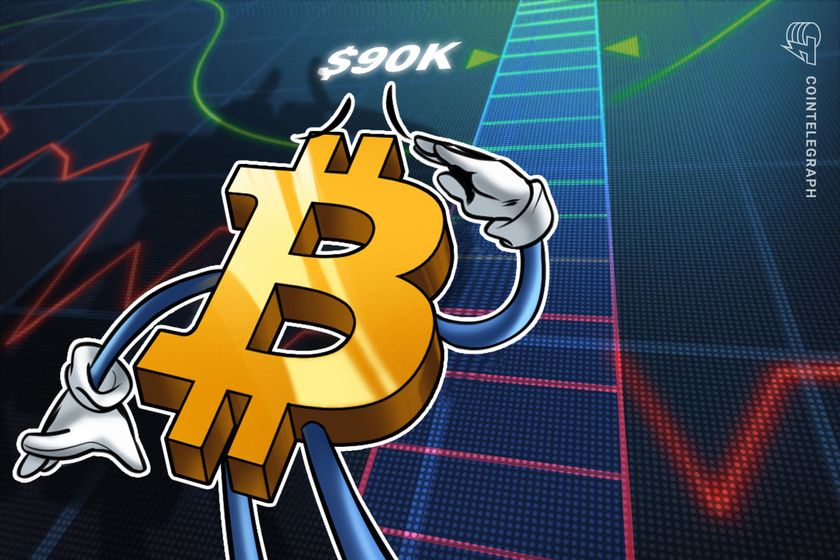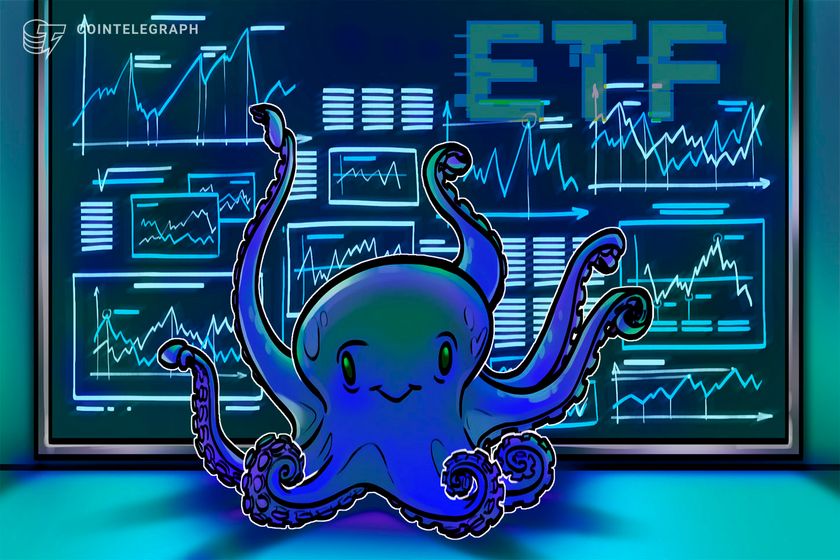Indicele fricii și lăcomiei
Top 7 câștigători
| Criptomonedă | Schimbare în ultimele 24 de ore |
|---|---|
 Fartcoin (fartcoin) Fartcoin (fartcoin) | 4.13% |
 Monero (xmr) Monero (xmr) | 3.59% |
| 2.22% | |
 Algorand (algo) Algorand (algo) | 1.47% |
 NEXO (nexo) NEXO (nexo) | 1.23% |
| 1.04% | |
| 1.01% |
Top 7 pierzători
| Criptomonedă | Schimbare în ultimele 24 de ore |
|---|---|
 Story (ip) Story (ip) | -10.45% |
 Ethena (ena) Ethena (ena) | -9.51% |
 Official Trump (trump) Official Trump (trump) | -7.64% |
 Jupiter (jup) Jupiter (jup) | -6.68% |
 Bitcoin Cash (bch) Bitcoin Cash (bch) | -5.87% |
 JasmyCoin (jasmy) JasmyCoin (jasmy) | -5.33% |
 Artificial Superintelligence Alliance (fet) Artificial Superintelligence Alliance (fet) | -5.2% |


The 2-year and 10-year US Treasury yields dipped on Monday, April 14, after Bitcoin (BTC) closed its best weekly performance since the second week of January. Bitcoin gained 6.79% over the past week, but are enough factors aligned to support continued price upside?
The 10-year treasury yield declined by 8.2 basis points to 4.40% during the New York trading session, while the 2-year treasury saw an 8 basis point slip to 3.88%. The drop in yields occurred on the back of possible tariff exemptions on smartphones, computers, and semiconductors, which were introduced to give US companies time to move production domestically. However, US President Donald Trump emphasized these exemptions were temporary in nature.
US 10-year treasury bond yields chart. Source: Cointelegraph/TradingView
The tariff exemptions announced on April 12 came at the end of a bullish week for Bitcoin. After forming new yearly lows at $74,500, BTC price jumped 15% to $86,100 between April 9-13.
Easing US treasury yields could be a double-edged sword for Bitcoin. Lower yields reduce the appeal for fixed-income assets, improving capital injection into risk-on assets like BTC. Still, the uncertainty of “temporary exemptions” and the ongoing trade war with China keeps Bitcoin susceptible to further price volatility.
As an “inflation hedge,” Bitcoin continues to draw mixed opinions, but recent uncertainty over trade policies increases inflation fears, improving BTC’s store of value narrative. Yet, recent US inflation data suggested a cooling trend, as the Consumer Price Index (CPI) for March 2025 indicated a year-over-year inflation rate of 2.4%, down from 2.8% in February, marking the lowest since February 2023, which could be indirectly bearish for Bitcoin in the short term.
Related: Trade war vs record M2 money supply: 5 things to know in Bitcoin this week
Bitcoin price hurdles present at $88K to $90K
Trading resource Material Indicators noted that Bitcoin retained a bullish position above its 50-weekly moving average and quarterly open at $82,500. A strong weekly close implied a higher possibility that Bitcoin is less likely to re-visit its previous weekly lows anytime soon. The analysis added,
“Bitcoin bulls now face strong technical and liquidity-based resistance between the trend line and the 200-day MA. Expecting “Spoofy” to move asks at $88k and $92k before they get filled.”
Likewise, Alphractal founder Joao Wedson suggested that Bitcoin may be nearing a bullish reversal, as the Perpetual-Spot Gap on Binance—a key indicator tracking the price difference between Bitcoin’s perpetual futures and spot markets, has been narrowing since late 2024.
Bitcoin Perpetual-spot price gap chart. Source: X.com
In a recent X post, Wedson highlighted that this shrinking gap, currently negative, signals fading bearish sentiment, with historical trends from 2020–2021 and 2024 showing that a positive gap often leads to a Bitcoin rally. Wedson noted that a flip to a positive gap could indicate returning buyer momentum. However, he cautioned that such negative gaps persisted during the 2022–2023 bear market.
Related: Michael Saylor’s Strategy buys $285M Bitcoin amid market uncertainty
This article does not contain investment advice or recommendations. Every investment and trading move involves risk, and readers should conduct their own research when making a decision.


Mantra CEO John Mullin addressed key concerns from the community following the sharp decline in the OM token during an Ask Me Anything (AMA) session hosted by Cointelegraph on April 14.
Mullin reassured users that Mantra and its partners are actively working to support the recovery of the Mantra (OM) token, though he noted that details around token buybacks and potential burns are still being developed.
“We’re still in the early stages of putting together this plan for potential buyback of tokens,” the CEO said, adding that the OM token recovery is Mantra’s “preeminent and primary concern right now.”
At the time of writing, OM traded at $0.73, slightly higher than its post-collapse low of $0.52 recorded on April 13 at around 7:30 pm UTC, according to data from CoinGecko.
“Baseless allegations”
In addition to denying reports claiming that key Mantra investors dumped the OM token pre-crash, the Mantra CEO also denied allegations that the Mantra team controls 90% of the token’s supply.
“I think it’s baseless. We posted a community transparency report last week, and it shows all the different wallets,” Mullin said, highlighting the “two sides” of Mantra’s tokenomics.
Source: Cointelegraph
“You have the Ethereum side and you have the mainnet side,” Mullin noted, adding the Ethereum-based token is hard capped and has been around since August 2020.
“The biggest holder of OM on exchange is Binance,” Mullin continued, referring the public to Etherscan records.
The top eight addresses of OM holdings. Source: Etherscan
However, the top OM wallet is currently held by crypto exchange OKX, which controls 14% of the circulating supply, or roughly 130 million tokens.
What’s next for Mantra’s $109-million MEF fund?
Mullin also addressed the Mantra Ecosystem Fund (MEF), a $109-million fund launched on April 7 in collaboration with its major strategic investors, including Laser Digital and Shorooq.
Other investors in the fund also included Brevan Howard Digital, Valor Capital, Three Point Capital, Amber Group, Manifold, UoB Venture, Damac, Fuse, LVNA Capital, Forte and others.
Related: Mantra bounces 200% after OM price crash but poses LUNA-like ‘big scandal’ risk
According to Mullin, the fund does not solely consist of Mantra’s OM token and has “dollar commitments and dollar contributions.”
Investors in Mantra’s $109-million fund. Source: Mantra
“We’ll continue to invest and support the ecosystem as part of this recovery plan,” the CEO stated.
End of the staking program on Binance
In the AMA, the Mantra CEO also said that a 38-million-OM transaction to the Binance cold wallet on April 14 is related to a staking program on Binance.
“It was actually Binance,” Mullin said, adding that Binance had OM tokens on its exchange that it was using as a staking program.
Source: Onchain Lens
“So, they just returned them because the staking program ended,” he said.
Mullin also emphasized that many of the transactions that caught the community’s reactions post-crash involved collaterals by an unnamed exchange.
“Effectively, those tokens were being used as collateral on an exchange. Then, the exchange decided that it was not the position they wanted to maintain anymore, for whatever reason,” Mullin said, adding:
“So, what happened was basically the positions were taken over by the exchange that took the collateral and started selling, which caused a cascade of sell pressure and forced more liquidations.”
Mullin said Mantra remains committed to addressing the situation as transparently as possible.
“We’re not running from anything,” he said, adding that the incident was a “very unfortunate situation.”
Magazine: Bitcoin eyes $100K by June, Shaq to settle NFT lawsuit, and more: Hodler’s Digest, April 6–12


Opinion by: Leroy Hofer, co-founder and CEO at Teneo Protocol
As the old wisdom goes, nobody knows you’re a dog on the internet. Often enough, nobody knows if you’re a bot either, to the point where the dead internet theory sometimes feels disturbingly tangible.
Bot traffic share hit its highest level in 2024, up 2% on the year before, according to the 2024 Imperva Bad Bot Report. The bot pandemic is ravaging the Web. People are taking notice — people like Chanpeng Zhao, for example, who recently urged Elon Musk to ban bots on X. He’s not the only one in the Web3 community to call for such measures, and rightly so.
From artificially inflating engagement metrics to orchestrating scams, bots are quickly drowning out real human interactions — and it’s at a time when our lives drift more and more into the online world.
While platform owners continue to roll out AI-driven moderation and paywalls to curb bot activity, these solutions fail to address the root problem. Moderation tools also regularly operate with minimal transparency — incorrectly flagging legitimate content without users knowing why.
Users also often have to surrender personal data to prove they are not bots, raising privacy concerns and creating barriers to participation. More problems are being made, and a decentralized approach is the only viable path forward.
If left to fester, the rise of bots will create repercussions that go way beyond social media. Companies pouring money into digital marketing will see their budgets wasted on fake engagement. It’s even possible to imagine a dirty trick where a rival would use bots to waste the competitor’s money by feeding them fake impressions — this already happens in the digital ad space.
People are — and will continue to become — more suspicious of online interactions, making it harder for authentic creators and businesses to earn trust. The user experience also suffers. As automated noise drowns out meaningful discussions, users may eventually abandon social media for good. We need to deal with the bot problem for all these and other reasons — once and for good.
The limits of centralized solutions
Social media giants have been using centralized moderation strategies to tackle the bots issue for quite some time. AI-driven detection systems serve as the first line of defense. They’re far from perfect. Bots are getting smarter, often slipping through the cracks by mimicking human behavior and bypassing safeguards. On top of that, false positives can lead to unfair restrictions on genuine users. Oh, the mighty banhammer, a weapon from a more civilized age.
Recent: CZ urges Elon Musk to ban bots on the X social media platform
Another common tactic is the implementation of paywalls, like X’s verification fees, which require users to pay for authentication. This method raises the financial hurdle for bot operators but also creates a two-tiered system that disadvantages users who can’t — or won’t — pay. Paywalls do little to deter well-funded bot farms that can easily overlook these costs. While these measures are well-meaning, they often miss the mark when balancing security with user accessibility.
A decentralized solution
A decentralized model hands the reins back to the users and offers an alternative to having centralized entities decide what’s real and what’s not. Using blockchain-based decentralized identity (DID) and reputation systems, platforms can verify real users without compromising their privacy. Decentralized solutions reduce the need for unclear moderation policies and empower people to control their own digital reputations across different platforms.
DID solutions enable users to verify their authenticity through cryptographic attestations, so intrusive Know Your Customer processes are unnecessary. Reputation-based systems can help to strengthen bot resistance by rewarding verified users with more social credibility while shrinking the impact of suspicious accounts. The real advantage here is that these systems operate transparently, preventing centralized authorities from imposing rules that may prioritize corporate interests over user rights.
Fixing social media’s bot problem without breaking it
The bot problem isn’t just a hassle — it’s a fundamental threat to the integrity of social media. The challenge is finding a solution that gets rid of bots without getting rid of free speech and user control. Centralized solutions are failing. Even worse, centralized systems also introduce new problems under the guise of security. A decentralized, data-driven approach enables people to authenticate themselves on their own terms, making bot-driven manipulation much harder.
We urgently need to move beyond the current system and push for decentralized solutions that protect users and bring authenticity back to social media. If social media is to be a space for genuine human interaction, it has to go decentralized before the bots make it useless.
Opinion by: Leroy Hofer, co-founder and CEO at Teneo Protocol.
This article is for general information purposes and is not intended to be and should not be taken as legal or investment advice. The views, thoughts, and opinions expressed here are the author’s alone and do not necessarily reflect or represent the views and opinions of Cointelegraph.


Crypto exchange Bybit has denied claims that it charges $1.4 million to list a token on its platform, following allegations made by a social media user with over 100,000 followers.
On April 14, X user “silverfang88” accused the exchange of demanding millions from projects in listing fees. The user also alleged that Bybit used key opinion leaders (KOLs) to silence students who were given trial contracts through the platform’s Campus Ambassador program.
Bybit CEO Ben Zhou denied the allegations, asking the social media user to provide evidence backing the claims. Zhou added that the crypto space has been chaotic because of rumors posted without evidence.
Source: Ben Zhou
Bybit denies $1.4-million listing fee accusation
In a statement sent to Cointelegraph, a Bybit representative clarified the requirements for listing on the crypto exchange.
According to Bybit, the exchange requires three things from projects: a promotion budget, a security deposit and an evaluation process.
“Projects are expected to allocate promotional funds for user engagement activities, though legal constraints prevent exchanges from holding tokens directly,” the representative told Cointelegraph.
Bybit said it asks for a deposit of $200,000–$300,000 in stablecoins to ensure promotional goals are met. Penalties may apply if the targets are not reached.
Apart from the promotional funds, the exchange said its listing process includes form submissions, internal voting, research and a listing review meeting. The representative told Cointelegraph:
“Evaluations focus on fundamentals and risk controls, including onchain data, address authenticity, use cases, user distribution, project value, token valuation, value capture mechanisms and team credentials.”
Related: Bybit integrates Avalon through CeFi to DeFi bridge for Bitcoin yield
User claims Bybit provided trial contracts to students
In addition to the listing fee allegations, the X user claimed that Bybit had provided trial contracts to students under its 2024 Campus Ambassador program and used KOLs to suppress complaints.
The account shared a Campus Ambassador program run by the trading platform in 2024 and said the issue was related to the program.
Zhou responded to those claims as well, again calling for proof. “Please show evidence if Bybit has done anything wrong,” he wrote on X.
The exchange has not responded directly to the specific claims related to its ambassador program at the time of publication.
Magazine: Memecoin degeneracy is funding groundbreaking anti-aging research
Solana’s Sol a raliat mai mult de 20% față de eter ( ETH) over the last seven days, and a trader is eyeing a potential breakout to $300, which would mark new all-time highs.
SOL/ETH ratio hits highest weekly close
The SOL/ETH ratio, which reflects the value of Solana in Ether, rose to 0.080 on April 13, marking the highest weekly close vreodată, conform datelor de la & nbsp ; Cointelegraph Markets Pro & nbsp ; și binance.
Pauză de tranzacționare Sol/Eth a format un nivel mai înalt pe graficul zilnic din 4 aprilie, sugerând un uptrend este în curs de desfășurare. src u003d "https: //s3.cointelegraph.com/uploads/2025-04/0196347e-426d-7853-9d46-fd09a8586bad " title u003d "" Alt u003d "Solana Rallies 20% împotriva Ethereum, dar este $ 300 Sol Price în interior ? Style u003d "text-align: Center ; " >
Sol/Eth Daily Chart. Sursa: Cointelegraph/ TradingView
The Sol/Eth Pair Grains Urmăriți A săptămâna bullish pentru solana , care a crescut cu 35% în ultimele șapte zile, împotriva unei creșteri de 13% în ET timp de timp.
& nbsp ; & ldquo ; graficul sol/eth tocmai a aruncat un semn de forță, & rdquo ; a spus pseudonyd u003d "null " > a spus pseudonys u003d "null " > a spus pseudonyd? O postare din 14 aprilie pe X, adăugând:
& ldquo ; Solana și -a închis cea mai înaltă închidere săptămânală împotriva lui Ethereum în istorie, reflectând că am putea vedea o performanță continuă a ecosistemului Solana. data-ct-non-breakable u003d "null " href u003d "https: //cointelegraph.com/news/bitcoin-all-time-high-109000-trump-inauguration-day " rel u003d "" target u003d "_ self " text u003d "null " title u003d "https: //cointelegraph.com/news/bitcoin-all-time-high-109000-trump-inauguration-day " > raliu în prețuri criptoase alimentat de președintele american Donald Trump & rsquo ; s inaugurație, care a văzut prețul pe scurtnotch a new all-time înalt of $ 295. poate solana prețul să ajungă $ 300 în aprilie ?
popular Crypto Trader Bitbull shared A CME Futures Futures On X care sugerează SOL Price ar putea să se desprindă către Trad. Consolidarea prețurilor eter & rsquo ; Pe măsură ce tranzacționează cu gama $ 120 și $ 130, a subliniat Bitbull, adăugând că SOL ar putea urma o dezlănțuire similară la nivelurile maxime de peste $ 300.


The market cap of Circle’s Euro Coin (EURC), a euro-pegged stablecoin, is growing quickly as the ongoing trade war pushes the US dollar price lower.
“In recent weeks, interest in the euro has grown tremendously” and “this interest has not escaped the Circle EURC stablecoin,” Obchakevich Research founder Alex Obchakevich wrote in a recent X post.
The euro has risen by 2.2%, reaching its highest price since February 2022 at its current price of $1.13.
Obchakevich said that amid this happening, decentralized finance (DeFi) protocol Aave saw €2.3 million of Euro Coin inflows in April alone. He further highlighted that EURC’s capitalization is growing at a rapid pace.
Source: Obchakevich’s
CoinMarketCap data shows EURC’s market cap rose from under $84 million at the end of 2024 to more than $198 million as of mid-April — a 136% increase year to date.
Related: ECB exec renews push for digital euro to counter US stablecoin growth
The euro grows amid an increasingly harsh trade war
The euro’s recent rally comes as the US dollar weakens on the back of escalating trade tensions. Since Dec. 31, 2024, the dollar has dropped from 0.97 euro to 0.88 euro, a 9.3% decline against the euro.
The US and European Union “are likely to reach an agreement on a trade deal that will stabilize the euro at $1.11 to the dollar,” Obchakevich said. Still, he expects the Euro Coin to keep growing:
“EURC will continue to grow through integration with various payment systems and blockchains.“
The analyst said that after launching on Ethereum, Euro Coin was also deployed on Avalanche, Base, Stellar, Sonic and Solana, leading to a growing supply. He shared his outlook on future market developments:
“I predict EURC to grow to 400 million euros by the end of this year. This will be further impacted by MiCa regulatory support and economic challenges.“
Related: Digital euro to be ‘most private electronic payment option’
MiCA works in Circle’s favor
Euro Coin and USDC (USDC) issuer Circle is reaping the rewards of its regulatory-friendly strategy. The firm’s products are the top euro and US dollar-pegged stablecoins that comply with the European Union’s Markets in Crypto-Assets (MiCA) regulation.
The current stablecoin market leader is Tether, with its USDt (USDT) stablecoin currently having a market cap of $144 billion according to CoinMarketCap data. This is significantly higher than leading stablecoin USDC’s $60 billion market cap.
Still, many expect this gap to shrink as the USDt keeps being pushed from the European Union’s market due to a lack of MiCA compliance. This trend culminated in the world’s leading crypto exchange, Binance, delisting USDt for its European Economic Area-based users to comply with the rules in March.
Magazine: How crypto laws are changing across the world in 2025


Kraken is expanding beyond cryptocurrencies by offering US-listed stocks and exchange-traded funds (ETFs) in a move aimed at appealing to more traditional investors.
Kraken, the world’s 13th largest centralized cryptocurrency exchange by volume, announced the launch of 11,000 US-listed stocks and ETFs with commission-free trading in an effort to bring “equities and digital assets together” under one trading platform.
As of April 14, US-based users in New Jersey, Connecticut, Wyoming, Oklahoma, Idaho, Iowa, Rhode Island, Kentucky, Alabama and the District of Columbia can access these stocks and ETFs within their Kraken account, the company announced.
Kraken expands to stocks and ETFs. Source: Kraken
The exchange plans to continue expanding access to clients in other US states, marking the first part of a “phased national rollout.”
Related: Trump’s tariff escalation exposes ‘deeper fractures’ in global financial system
Both traditional and cryptocurrency investor sentiment took a significant hit after US President Donald Trump’s reciprocal import tariff announcement on April 2.
Kraken’s traditional stock offering comes over a week after the S&P 500 posted a $5-trillion loss in market capitalization over two days, marking its largest drop on record, surpassing a $3.3-trillion decline in March 2020 after the first wave of the COVID-19 pandemic.
Related: 70% chance of crypto bottoming before June amid trade fears: Nansen
Crypto is “becoming the backbone for trading”
Kraken’s expansion into traditional investment products signals the growing utility of cryptocurrencies and blockchain technology, according to Arjun Sethi, co-CEO of Kraken.
“Crypto isn’t just evolving, it’s becoming the backbone for trading across asset classes, such as equities, commodities and currencies. As demand for 24/7 global access grows, clients want a seamless, all-in-one trading experience.”
Sethi added that expanding into traditional equities is a “natural step” toward the tokenization of real-world assets and the “borderless” future of trading built on blockchain rails.
Kraken also plans to expand its stock trading offering to other large international markets, including the United Kingdom, Europe and Australia.
Magazine: Illegal arcade disguised as … a fake Bitcoin mine? Soldier scams in China: Asia Express
Tranzacții mari
| Criptomonedă | Expeditor | Destinatar | Sumă (USD) | Când |
|---|---|---|---|---|
| Binance | Kraken | $2004075.5 | cu mai puțin de un minut în urmă | |
| Binance | Binance | $3006114.8 | 1 minută în urmă | |
| Unknown | Unknown | $1989871.5 | 2 minute în urmă | |
| Unknown | Unknown | $3979743 | 2 minute în urmă | |
| Unknown | Unknown | $1231112.2 | 2 minute în urmă | |
| Unknown | Unknown | $1989871.5 | 3 minute în urmă | |
| Unknown | Unknown | $19023304 | 3 minute în urmă | |
| Coinbase | Unknown | $8710671 | 3 minute în urmă |
Evenimente economice importante pentru astăzi
| Timp | Eveniment | Țară |
|---|---|---|
| 20:00:00 | Corporația soldului comercial | Noua Zeelandă |
| 23:30:00 | Rezerve săptămânale de ulei brut conform Institutului American de Oil (API ) | Statele Unite |
| 20:00:00 | Corporația soldului comercial | Noua Zeelandă |
| 19:00:00 | Președintele BCE Lagarde va face un discurs | Zona euro |
| 15:30:00 | Volumul vânzărilor în sectorul producției | Canada |
| 15:30:00 | Prețuri de consum (IPC ) | Canada |
| 15:30:00 | Preț de consum de bază (IPC ) | Canada |
| 15:30:00 | Indicele activității de producție a statului Empire din NY | Statele Unite |
| 15:30:00 | Indicele prețurilor la import | Statele Unite |
| 15:30:00 | Indicele prețurilor la export | Statele Unite |
| 15:15:00 | Volumul construcției de case noi | Canada |
| 15:00:00 | Valoarea indexului Globaldaidrade | Noua Zeelandă |
| 14:00:00 | Indicele inflației IGP-10 | Brazilia |
| 13:30:00 | Prețuri de consum (IPC ) | India |
| 12:00:00 | Indicele de dispoziție economică de la ZEW | Zona euro |
| 12:00:00 | Volumul producției industriale | Zona euro |
| 12:00:00 | Indexul de dispoziție economică ZEW în Germania | Germania |
| 12:00:00 | Indicele condițiilor economice actuale ZW în Germania | Germania |
| 11:00:00 | Raportul lunar al IMA | Statele Unite |
| 11:00:00 | Soldul bugetar | Curcan |
| 11:00:00 | Prețuri de consum (IPC ) | Polonia |
| 09:45:00 | Indicele de preț de consum armonizat al Franței | Franţa |
| 09:45:00 | Prețuri de consum (IPC ) Franța | Franţa |
| 09:30:00 | Indicele prețurilor cu ridicata | India |
| 09:00:00 | Nivelul șomajului | Marea Britanie |
| 09:00:00 | Schimbare de angajare, 3m/3m | Marea Britanie |
| 09:00:00 | Modificarea numărului de aplicații pentru prestații de șomaj | Marea Britanie |
| 09:00:00 | Nivelul mediu de salarii ținând cont de primele | Marea Britanie |
| 04:30:00 | Protocolul reuniunii privind politica de credit și bani | Australia |